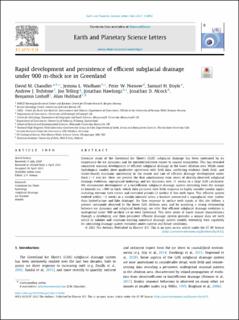| dc.contributor.author | Chandler, David Matthew | |
| dc.contributor.author | Wadham, Jemma Louise | |
| dc.contributor.author | Nienow, Peter W. | |
| dc.contributor.author | Doyle, Samuel H. | |
| dc.contributor.author | Tedstone, Andrew J. | |
| dc.contributor.author | Telling, Jon | |
| dc.contributor.author | Hawkings, Jonathan R. | |
| dc.contributor.author | Alcock, Jonathan | |
| dc.contributor.author | Linhoff, Benjamin | |
| dc.contributor.author | Hubbard, Alun Lloyd | |
| dc.date.accessioned | 2021-05-20T13:47:29Z | |
| dc.date.available | 2021-05-20T13:47:29Z | |
| dc.date.created | 2021-05-12T15:44:47Z | |
| dc.date.issued | 2021 | |
| dc.identifier.issn | 0012-821X | |
| dc.identifier.uri | https://hdl.handle.net/11250/2755928 | |
| dc.description.abstract | Intensive study of the Greenland Ice Sheet's (GrIS) subglacial drainage has been motivated by its importance for ice dynamics and for nutrient/sediment export to coastal ecosystems. This has revealed consistent seasonal development of efficient subglacial drainage in the lower ablation area. While some hydrological models show qualitative agreement with field data, conflicting evidence (both field- and model-based) maintains uncertainty in the extent and rate of efficient drainage development under thick (∼1 km) ice. Here, we present the first simultaneous time series of directly-observed subglacial drainage evolution, supraglacial hydrology and ice dynamics over 11 weeks in a large GrIS catchment. We demonstrate development of a fast/efficient subglacial drainage system extending from the margin to beneath ice >900 m thick, which then persisted with little response to highly variable moulin inputs including extreme melt events and extended periods (2 weeks) of low melt input. This efficient system evolved within ∼3 weeks at a moulin initiated when a fracture intersected a supraglacial river (rather than hydrofracture and lake drainage). Ice flow response to surface melt inputs at this site follows a pattern commonly observed in the lower GrIS ablation area, and by assuming a strong relationship between ice dynamics and subglacial hydrology, we infer that efficient subglacial drainage evolution is widespread under 900 m-thick ice in west Greenland. This time series of tracer transit characteristics through a developing and then persistent efficient drainage system provides a unique data set with which to validate and constrain existing numerical drainage system models, extending their capability for simulating drainage system evolution under current and future conditions | |
| dc.language.iso | eng | en_US |
| dc.rights | Navngivelse 4.0 Internasjonal | * |
| dc.rights.uri | http://creativecommons.org/licenses/by/4.0/deed.no | * |
| dc.title | Rapid development and persistence of efficient subglacial drainage under 900 m-thick ice in Greenland | en_US |
| dc.type | Journal article | en_US |
| dc.type | Peer reviewed | en_US |
| dc.rights.holder | © 2021, Authors | |
| dc.description.version | publishedVersion | |
| cristin.ispublished | true | |
| cristin.fulltext | original | |
| cristin.qualitycode | 2 | |
| dc.identifier.doi | 10.1016/j.epsl.2021.116982 | |
| dc.identifier.cristin | 1909769 | |
| dc.source.journal | Earth and Planetary Science Letters | en_US |
| dc.relation.project | Norges forskningsråd: 223259 | |

